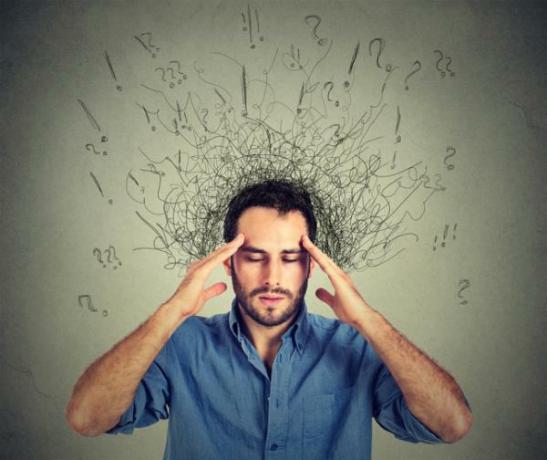
We live in a society with a hectic pace of life. We attend to all the stimuli that are around us, we must make decisions quickly and constantly, perform numerous tasks and combine a large number of activities. All this requires a general activation of our body and the implementation of resources that allow us to meet all the demands of our day to day.
Sometimes our thinking is accelerated to respond to all these circumstances. However, this thinking can appear abnormally accelerated in some disorders, which is known as tachypsychia. In this Psychology-Online article, we talk about the Tachypsychia: what it is, symptoms, causes and treatment.
Index
- What is tachypsychia
- Symptoms of tachypsychia
- Causes of tachypsychia
- Treatment of tachypsychia
What is tachypsychia.
What does tachypsychia mean? It can be understood by two different definitions. We see them below.
Tachypsychia as a perception of the passage of time
The American Psychiatric Association defines tachypsychia as an altered perception of time in which time seems to go faster or slower.
This term is linked to the concept of psychological time, which is the subjective estimate of time. This estimate will be conditioned by internal factors, for example, we perceive that time passes slower when we get bored or spend more fast when we are having fun or by external factors, for example, if we are exposed to unpleasant stimuli we will perceive that time passes more slowly.
In addition, this perception of time can be altered by the effects of some substances. However, this definition of tachypsychia does not indicate that the term is pathological. In this case, it would be a non-pathological distortion of time perception in most cases and pathological in case it was caused by the effect of some substance.
Tachypsychia as a thought disturbance
The concept tachypsychia in psychology is also used to describe a formal or course of thought disorder. In this sense, tachypsychia would refer to a abnormal acceleration of thinking. The opposite extreme would be represented by bradypsychia or slowing down of thought.
You may think that in some disorders, such as anxiety disorders, people think about the same things a lot, they don't stop thinking and their heads are like a pressure cooker. This concept refers to rumination, which is different from acceleration of thought or tachypsychia.
Symptoms of tachypsychia.
Racing thinking or tachypsychia is not a diagnostic category. It is not a syndrome made up of a series of symptoms. On the contrary, this phenomenon constitutes a symptom in itself which may be present in disorders such as the following:
- Bipolar disorders: specifically, tachypsychia would be one of the symptoms of manic, hypomanic and depressive episodes with mixed characteristics.
- Psychotic disorders What schizophrenia.
The abnormal acceleration of thought is manifested by language through the "flight of ideas." There are publications that also take the flight of ideas as an extreme form of the acceleration of thought characterized by:
- Speech accelerated in which many words appear in a very short time.
- Disjointed ideas each.
- Jumps impulsively from one topic to another.
- Distracibility.
- In severe cases, the speech is incoherent and disorganized.
Causes of tachypsychia.
Tachypsychia is a symptom of some disorders. One of them, perhaps the one with which he has been most associated, is bipolar disorder. In this context, the acceleration of thought occurs as a consequence of the abnormally elevated mood.
The flight of ideas is also found in psychotic disorders, such as schizophrenia, in which thought is altered in its form and content. I mean, there is a altered way of thinking, for example, very quickly, and what you think about, for example, the delusions. These would be some examples of tachypsychia.
Schizophrenia has numerous explanatory theories of a biopsychosocial nature that try to explain the causes of its alterations.
Treatment of tachypsychia.
We have discussed the two main disorders in which this acceleration of thought appears, bipolar disorders and psychotic disorders. For treatment, therefore, we must take into account the disorder in which this accelerated thinking is appearing.
Considering tachypsychia as a symptom of both, below, we will review the treatment for both groups of disorders, considering that this treatment will have an effect on said symptom.
Antipsychotic drugs
Antipsychotic medication is used in both groups. Treatment of tachypsychia, in the case of Bipolar disorder, is used mainly in the manic and hypomanic phases. Remember that accelerated thinking appears in these. One of the antipsychotics used for schizophrenia is sulpiride and, in the case of bipolar disorder, one of those used is olanzapine.
Mood stabilizers
As we have seen previously, one cause that can lead to accelerated thinking is abnormally high mood. Therefore, treatment with mood stabilizers such as lithium or valproic acid should lead to an improvement in racing thinking.
Psychological therapy
In the case of bipolar disorder, psychoeducation and cognitive behavioral therapy which will act, among other elements, on manic impulses.
In the case of psychotic disorders, the following psychological therapies are used:
- Deactivation techniques, exposure, operant methods, cognitive therapies and self-control and biofeedback strategies.
- Neuropsychological rehabilitation: for example, in the case of accelerated thinking, they can operate on attention to reduce distractions.
- Other components such as training in social skills, troubleshooting, etc.
This article is merely informative, in Psychology-Online we do not have the power to make a diagnosis or recommend a treatment. We invite you to go to a psychologist to treat your particular case.
If you want to read more articles similar to Tachypsychia: what it is, symptoms, causes and treatment, we recommend that you enter our category of Clinical psychology.
Bibliography
- Godoy, J.F., Godoy-Izquierdo, D. and Vázquez, M.L. (2014). Spectrum of schizophrenia and other psychotic disorders. In Caballo, V.E., Salazar, I.C. And Carrobles, J.A. Manual of Psychopathology and Psychological Disorders. Madrid. Pyramid.
- Gómez-Fontanil, Y. and Coto, E. (2008). Thought psychopathology (I): formal thought disorders. In Belloch, A., Sandín, B. and Ramos, F. (2008) Manual of psychopathology. Volume I. Madrid: McGraw-Hill.
- Ramos, F. and Manga, D. (2008). Language psychopathology. In Belloch, A., Sandín, B. and Ramos, F. (2008) Manual of psychopathology. Volume I. Madrid: McGraw-Hill.
- Sevillá, J., Pastor, C. and Ruiz, L. (2014). Bipolar disorder and related disorders. In Caballo, V.E., Salazar, I.C. And Carrobles, J.A. (2014) Manual of Psychopathology and Psychological Disorders. Madrid. Pyramid.
Tachypsychia: what it is, symptoms, causes and treatment


